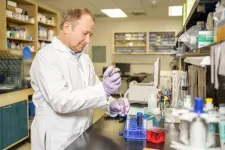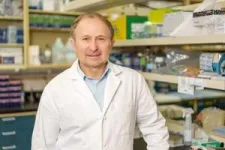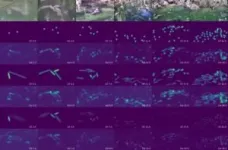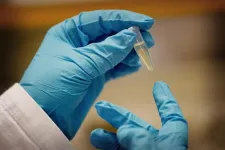(Press-News.org)
With an estimated 1.9 million new cases and more than 600,000 deaths each year, cancer remains the second most common cause of death in the U.S., trailing only heart disease. And while there are more than 200 types of cancer, the abnormal synthesis of a protein known as STAT3 is unique to the majority of tumors.
STAT3 is known as a transcriptional regulator, which means it regulates the expression of several genes. In fact, STAT3 is associated with approximately 70% of all human tumors and is responsible for uncontrolled cell growth and disease progression.
To investigate new approaches to inhibit STAT3 and develop new cancer treatments, the National Institutes of Health-National Cancer Institute recently awarded a two-year, $153,000 grant (“Development of an Anti-Cancer Approach Through a Novel Pathway of Translational Regulation”) to Andrey Karamyshev, Ph.D., from the Texas Tech University Health Sciences Center School of Medicine.
Regardless of a tumor’s type or location in the body, elevated STAT3 levels are known markers of unfavorable cancer prognoses. Because of that, Karamyshev said inhibiting STAT3 became a popular starting point for researchers seeking to develop new cancer treatments.
“You just inhibit this one protein and you cure 70% or more of all cancers, so it was an attractive target for many years,” Karamyshev said. “Unfortunately, all trials that used small molecules to directly inhibit the STAT 3 protein failed because when STAT3 interacted with the molecules, it created an aggregation that inhibited certain cell functions that are dependent on STAT3, which led to high toxicity.”
As additional research demonstrated that STAT3 could not be directly inhibited, Karamyshev began investigating ways to indirectly inhibit the protein, such as disrupting its synthesis or stability. Because disrupting STAT3 stability was unsuccessful in several other studies, he focused his research on disrupting STAT3 at the translation level during its synthesis by ribosomes, which are the molecular machines that make proteins, including STAT3.
Several years ago, Karamyshev’s lab discovered a specific pathway known as the RAPP (Regulation of Aberrant Protein Production). Though RAPP was not relevant to STAT3 at the time, that work also showed that if protein synthesis is disrupted on the ribosome, the protein’s mRNAs are specifically degraded. Karamyshev hypothesized that inhibiting STAT3 synthesis at this level could lead to new treatments for cancer, so he began looking for proteins that can interact with and disrupt STAT3 during its synthesis on the ribosomes.
“This is the major difference in our research,” Karamyshev said. “We are looking for the elements of the protein synthesis and how the protein — STAT3 in this case — interacts with other proteins. The idea is if we can identify these interacting proteins, we can inhibit them, which will push the ‘button’ for downregulation of STAT3.”
When Karamyshev’s lab discovered the RAPP pathway, they were actually studying proteins that are secreted outside of the cell. They noticed that when these secretory proteins cannot be recognized by a specific protein complex (a signal recognition particle, or SRP) which is required for transport, the mRNA templates degraded. However, as a transcriptional regulator, STAT3 is shuttled between the cell’s cytoplasm and nucleus, and it is not a secretory protein.
Because the proteins regulating STAT3 mRNA stability on the ribosome are not known yet, the current project is directed toward identifying these new RAPP components that interact with STAT3 on the ribosome during its synthesis. Once these components are identified, they can be inhibited to decrease the level of STAT3 mRNA level. This approach could help scientists develop new anti-cancer treatments, and the preliminary results obtained by Karamyshev’s lab demonstrate the proof of principle to develop this approach.
“This is a very new concept that shows we can regulate STAT3 indirectly and we can downregulate its expression,” Karamyshev said. “It can open new opportunities to find specific molecules which can target the RAPP pathway components instead of the STAT3. And when certain small molecules are found to be insufficient to directly downregulate STAT3 activity or expression, we can use a completely different set of molecules that regulate the other proteins which are involved in indirect STAT3 inhibition. The concept is very simple: you push a ‘button’ and it triggers a decrease of STAT3, which can ultimately result in new treatments for many cancers.”
###
END
Flat-faced dog breeds are popular all over the world. In the USA and in Hungary, the French Bulldog is currently the most common breed. However, their popularity comes at a high cost in terms of health: shortened skulls are associated with deteriorative brain morphology changes, breathing difficulties and sleep problems. According to recent findings by Hungarian researchers, flat-faced dogs sleep more because their breed-specific sleep apnea increases daytime sleepiness, their REM sleep phase is longer than ...
The University of Texas at San Antonio today announced the selection of David Brown as the new executive director of its National Security Collaboration Center (NSCC) and professor of practice. Brown will join UTSA with decades of experience leading collaborative research and development ecosystems supporting U.S. national defense strategies.
Brown is a trusted, well-connected leader in civilian and military communities nationwide who has especially strong relationships within U.S. Department of Defense (DoD) organizations, laboratories and commands and has gained national recognition for his transformative leadership in federal research ...
Studies on sustainability inevitably touch on food-related topics like food security, culinary heritage, and the sustenance of vulnerable people. Social sustainability is one of the three pillars of sustainability, alongside environmental and economic sustainability, and has become a pivotal topic in various research fields. It includes concerns about social justice, resource distribution and recognition, and political participation of marginalized groups at the local community level.
Very few studies of social sustainability have looked at urban foodways in terms of social and cultural infrastructure. More often than not, scholars in Japan have ...
The transition to a society without fossil fuels means that the need for batteries is increasing at a rapid pace. At the same time, the increase will mean a shortage of the metals lithium and cobalt, which are key components in the most common battery types. One option is a sodium-ion battery, where table salt and biomass from the forest industry make up the main raw materials. Now, researchers from Chalmers University of Technology, Sweden, show that these sodium-ion batteries have an equivalent climate impact as their lithium-ion counterparts – without the risk of running out of raw materials.
"The materials ...
Research Highlights:
An analysis of death certificate data from 1999 to 2020 showed a decline in deaths related to infective endocarditis throughout most of the United States yet found an alarming increase of 2%-5% among adults ages 25-44.
There was a notable increase in the diagnosis of substance use disorder among the young adults with infective endocarditis listed as the underlying cause of death.
Three states at the epicenter of the opioid crisis— Kentucky, Tennessee and West Virginia — had significant increases in death rates related to infective endocarditis.
Embargoed until 4 a.m. CT/5 a.m. ET Wednesday, Dec. 13, 2023
DALLAS, Dec. 13, 2023 — ...
Smartwatches can help physicians detect and diagnose irregular heart rhythms in children, according to a new study from the Stanford School of Medicine.
The finding comes from a survey of electronic medical records for pediatric cardiology patients receiving care at Stanford Medicine Children’s Health. The study will publish online Dec. 13 in Communications Medicine.
Over a four-year period, patients’ medical records mentioned “Apple Watch” 145 times. Among patients whose medical records mentioned ...
VANCOUVER, Wash. – Even in the precipitation-heavy Pacific Northwest, more frequent heatwaves are threatening a key source of water supply.
A Washington State University study that intended to look at snow melting under a single, extreme event, the 2021 “heat dome,” instead revealed an alarming, longer-term rising trend of successive heatwaves melting snowpack earlier in the year.
The findings have implications for many areas worldwide that are dependent on snow-capped mountains to provide summer water since heatwaves have been on the rise globally.
“Short-term ...
Barcelona and Johannesburg, December 13th, 2023
The Scientific Group, a leader in the IVD industry, and Inbiomotion, a company commercializing its proprietary MAF Test® for identifying high risk early-stage breast cancer patients have signed an agreement to start marketing MAF Test® in Sub-Saharan Africa. The MAF Test® predicts the prognosis of breast cancer patients and helps oncologists to identify those patients who may be able to prevent recurrence and benefit from adjuvant treatment with bisphosphonates, which are commonly used to treat osteoporosis. The test also identifies those patients whose prognosis would worsen if treated with bisphosphonates.
Breast ...
People with cognitive disabilities – like autism, attention deficit and memory loss – are less satisfied with their health care than those in the general population, according to a study published by a Rutgers researcher.
The study, published in Disability and Health Journal, examined how a national sample of adults experience the care they receive and the factors that contribute to their experiences.
“People with cognitive disabilities were less likely than people without ...
In the future, a little saliva may be enough to detect an incipient cancer. Researchers at the University of Gothenburg have developed an effective way to interpret the changes in sugar molecules that occur in cancer cells.
Glycans are a type of sugar molecule structures that is linked to the proteins in our cells. The structure of the glycan determines the function of the protein. It has been known for a while that changes in glycan structure can indicate inflammation or disease in the body. Now, researchers at the University of Gothenburg have developed a way to distinguish different ...








